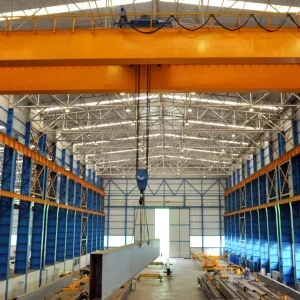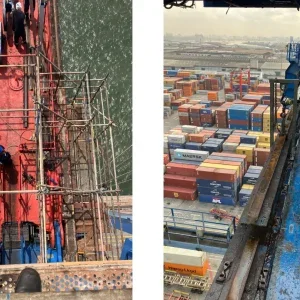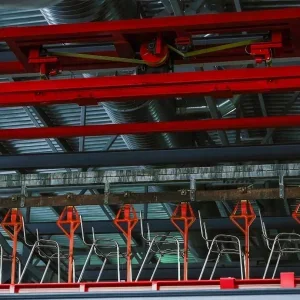It has been a challenging start to the year for those involved in the manufacturing sector. In the US, the Institute for Supply Management’s Purchasing Managers index (PMI) fell four tenths of a percentage point to 48.2 in December 2015.
As 50 is the ‘dividing line’ between growth and decline, these latest figures indicate that manufacturing activity is contracting. And looking at other geographies paints a similar picture. India’s steel sector is suffering when it comes to production, while major efforts are being made in places such as Zimbabwe to revive its flagging manufacturing fortunes.
According to Don Norman, director of economic studies at the MAPI Foundation, a research affiliate of MAPI, the Manufacturers Alliance for Productivity and Innovation in the US, January was one to endure, rather than enjoy for many in the US.
"With slowing growth in China and the implosion of stock prices there, coupled with the dramatic fall in the price of oil, and recent volatility in U.S. equity markets, January is coming in like a lion," he explained in the foundation’s January manufacturing update.
MANUFACTURING DECLINE
Key figures from the latest update show a 0.5 percent change decline in machinery manufacturing, a 1.7 drop in motor vehicles and parts and a 0.6 fall in pharmaceutical. Aerospace remained flat at 0.0.
"Repeating the pattern observed in recent years, the first quarter will be challenging for U.S. manufacturers. One might say that what is happening bears watching. Or, one could say that the bears are watching what is happening," he says. "The indexes of new orders and production, however, increased by three tenths and six tenths of a percentage point, respectively. Both remain just below 50. The employment index fell three-tenths of a percentage point and is back below 50, indicating decline. The supplier deliveries index decreased, but a decrease in this index signals that deliveries are growing." He adds: "The manufacturing index slipped one-tenth of a percent in December, and was just eight-tenths of a percent above its December 2014 level. The index was up and down throughout 2015. For the year as a whole manufacturing output grew by 2 percent."
While 2016 is gearing up to be a challenging 12 months for many manufacturing firms, the role overhead lifting equipment businesses play in the manufacturing equation remains a key one and, as such, there have been some key projects taking place in recent months.
AUTOMOTIVE INVESTMENT
In the US, Ace World Companies has installed a 40USt capacity overhead crane, complete with 20USt auxiliary hoist, at automotive manufacturer Nissan’s facility in Canton, Mississippi.
The new 116ft span crane replaces an older unit that has been in operation since the facility was built 12 years ago and will be used for loading and unloading dies for Nissan Canton’s stamping presses.
The crane will also be used to flip the dies when they are being repaired. The process involved blank steel sheets going through one of three large stamping presses where they become body panels, such as hoods, fenders, doors and body sides.
Kevin Beavers, operations manager, at Ace World Companies’ Knoxville division, explains: "The overhead crane is crucial to the production line. Every car, truck and van produced at the facility starts as a coil of raw steel. The steel is rolled out and travels through a press, where it is then cut into blank sheets.
"As formed panels exit the presses, technicians inspect them to ensure quality, before placing them in storage racks. Ace’s lifting equipment is integral to the safety and efficiency of this production process." Its stamping presses tower 36ft above the plant floor, more than 20ft below the floor and yield up to 6,000USt of force. He adds: "We are extremely proud not only of this installation but of the part we have played in the lifecycle of this particular manufacturer and our reputation for providing industry-leading lifting solutions to the automotive sector.
"We have supplied a variety of cranes and hoists for the industry over the years. An automated system incorporating 22 hoists that worked in conjunction to dip frames into various tanks was another that will live long in the memory."
The manufacturer has also shipped the first six of 23 cranes for Big River Steel’s $1.3bn steel mill and recycling facility located in Osceola, Arkansas.
The cranes commissioned by the hot mill range in capacity from 10 to 135USt, with all machines installed by the end of March 2016. Its cold mill will take delivery of the remaining equipment that May.
The largest crane, a 135USt capacity system, features a 40USt auxiliary hoist that will be used to handle a caster tundish, while a single 10USt unit will be used for maintenance. Other cranes in the setup include nine of 100USt capacity with 20USt auxiliary hoists and two 100USt capacity machines with 35USt auxiliaries.
Camron Ghanemi, vice president at Ace World Companies, says, given the magnitude of the order, to have shipped the first six cranes and be on schedule is very rewarding.
"We are proud to be partnering with Big River on the landmark project and look forward to the on-time completion of the job early this year," he says.
Most of the cranes in the order are from Ace’s standard steel mill design and equipped to handle steel coils. The Big River Steel Osceola facility combines the "cost advantages and flexibility of a traditional mini mill" with the production capabilities in gauge, grade and width of an integrated mill.
It will produce a range of high-strength, lightweight steels used in the automotive industry; wide and thick steels used in the most demanding pipe and tube applications; and electrical steels used in the energy industries.
When complete, the Osceola mill is expected to be able to produce 1.6 millionUSts of flat rolled steel products and will employ approximately 450 employees. Its location provides the manufacturer with access to the vast majority of domestic steel consumers as well as raw material supplies from across the nation.
Ace’s Kevin Beavers, who oversaw the sales process, adds: "This is the largest crane order in the history of Ace World Companies. This has been a huge accomplishment for me and the company to get an order of this scale."
STEEL TREATMENT
Away from the US, Stahl CraneSystems has collaborated with its Dutch partner CraneBuilders to install an overhead lifting unit for Nedstaal in the Netherlands. The client produces high-quality steel for steel treatment companies, with its core business centred on made-to-order small batches of 30 to 50 tonnes.
With the in-house locomotive arrives every few minutes, it brings moulds with red-hot, fresh-cast steel, while the casting moulds, or chill moulds, are unloaded to cool down, opened, cleaned and stored temporarily.
Two grab cranes, installed by the lifting manufacturers, operate under the building’s ceiling and load and unload locomotives and lorries around the clock.
René Rohde, CraneBuilders’ project manager explains: "Nedstaal needed a particularly robust and reliable crane in this environment. Our crane system works with Stahl CraneSystems wire rope hoists and a grab with an off-standard rope bracing system. "By working together and making use of the versatile German crane technology we were able to develop the ideal crane system for our customer."
Nedstaal produces high-quality steel for steel treatment companies. Its core business is made-to-order small batches of 30 to 50 tonnes. Steel is not just steel: Nedstaal is able to produce hundreds of different types of steel depending on the composition of the raw materials and the processing..
The newly-installed crane in the front section of the building is equipped with a grab for picking up steel cylinders safely and quickly. The grab is lifted and lowered by two wire rope hoists mounted on a double rail crab.
In this type of grab, extremely high forces act on the rope drum and cause the rope and rope guide to wear quickly.
Short maintenance intervals and unplanned downtimes would be the result of this. CraneBuilders’ Marco Lindhout, says: "We worked together with Stahl CraneSystems and developed a low-wear solution with two wire rope hoists specially adapted to this application.
"Our design means that the grab can be moved absolutely vertical and without rotating, even if there is a slight asynchronism or one of the hoists comes to a stop. A sophisticated rope bracing system at a set distance below the wire rope hoists makes this possible."
According to Stahl CraneSystems’ area sales manager Peter Kittsteiner, who was involved in developing the solution, the customised rope reeving over several sheaves holds the load free of oscillations during travel and the angled ropes have a stabilising effect.
"This also avoids stress on the rope drum caused for example by diagonal pull. Sometimes you don’t need that much technology – a lot of problems can be solved intelligently and extremely efficiently with plenty of experience and the right idea," CraneBuilders’ Lindhout adds. For the crane to function trouble-free in spite of the high build-up of dust, CraneBuilders employed two AS 7 wire rope hoists from Stahl CraneSystems.
These hoists are regarded as particularly reliable, they are low-maintenance and have no trouble coping with high ambient temperatures and adverse conditions. Rohde concludes: "The AS 7 was the best product for this project. Stahl CraneSystems was able to customise the wire rope hoists for our design, installation was simple, commissioning unproblematic, and the crane has been running since without incident – in spite of the thick layer of dust which has built up on the crane in just a few weeks."
FABRICATION EXPANSION
Elsewhere, in South Africa, SWF Krantechnik is working with long-standing partner, Johannesburg’s Pro Crane Services (PCS), on a crane project for fabrication business Hydra Arc.
With PCS designing, manufacturing and installing the crane, SWF is providing the hoisting technology. With a load capacity of 500t, and a rope drum diameter of 1.75m, the winch is one of the most powerful The rope has a diameter of 36mm and a length of 500m. The hoisting unit has been classified according to FEM 1BM / M3 while the dead weight of the winch is 42 t.
SWF’s electric wire rope hoist, known as NOVA NE, has a load capacity of 40 t and is used as an auxiliary hoist. Its double girder trolley has been classified according to FEM 1AM / M4.
Both of the hoisting units are mounted on the double girder crane with a gauge of 4.2 m, while the span width of the crane is 23m with a lifting height of 19.5m. Owing to the tandem function, both hoisting units can be controlled simultaneously or, if necessary, individually.
The company explains: "The winch features the crane intelligence function ESR (Extended Speed Range). This function boosts productivity in the partial-load range.
"When lifting lighter loads, the excess and unused motor performance is used to increase the maximum possible lifting speed. The possible lifting speed is calculated automatically and enables smooth lifting. Two boogie end carriages, each with eight wheels and a diameter of 710 mm, are responsible for the powerful crane drive.
"Four of the wheels on each end carriage are powered by electrical motors. The swivelling connectors ensure that all the wheels lies on the crane rail so that the wheel loads are optimally distributed."
The customer, Hydra Arc, produces components and containers for the petrochemical industry, and given the large dimensions of the components required and the resulting weights, the company decided to procure three powerful crane systems each with a load capacity of 500 t.
POWER TRANSMISSION
Finally, German business KTR Kupplungstechnik has kitted out its new Power Transmission Center with a raft of Demag components and systems. The new setup comprises KBK modular crane system and single-girder suspension cranes, while larger items are assembled with the aid of wall-mounted slewing jib cranes and a double-girder travelling crane spans the entire central bay.
KTR manufactures power transmission components such as shaft couplings, flange couplings and torque limiters. Its new PTC, in Rheine, Germany, features a 130m long main building with three bays, and two bays are divided into function units that each measure 6m x 6m.
The middle bay features 18 workplaces, each equipped with single-girder suspension cranes from the KBK system and Demag DC-Com chain hoists. The crane bridges each measure 6m in length and travel on four crane runways that measure between 18.5 and 54.5 m long. Reinhard Wibbeling, head of design/ research & development at KTR says: "For reasons of flexibility, it was important for us to keep the factory bays clear of any columns.
"However, since the workplaces are only equipped with a bench, tool cabinet and power supply connections at one end, only one of four sides was available for installation. For this reason, we decided in favour of a selfsupporting profile section solution."
The site features cantilever profile beams that have an outreach of more than 6m installed on the pillars that support the building’s roof. KBK crane runways are installed on these beams, which utlises Demag KBK II-H steel profile section.
This makes it possible to achieve distances between suspensions of 6m for loads on the profile section of up to 1,400kg. Elsewhere, the second bay is designed for the assembly of larger couplings and features four wall-mounted slewing jib cranes (two each with 1 t and 2 t capacities) are used for handling the components. Owing to their outreach of 6m and slewing range of 180 degrees, they can reach "virtually any point" of a workplace.
Wibbeling explains: "We spoke to several suppliers. Terex Material Handling met our expectations in terms of flexibility and, at the same time, a high load capacity with its Demag product range. We are also highly satisfied with the help and advice that we received in advance."






